If you're like me and spend hours after hours in front of the computer, you're likely to experience wrist discomforts and maybe even pains. This is called Carpal Tunnel Syndrome. Don't worry, you're not the only one, about 3 in 100 people develop carpal tunnel syndrome at some point in their life. Over half of these are women. While it can develop at any age, the chance of it occurring increases with age. It is most common in people in their 40s and 50s.
Sometimes carpal tunnel syndrome can be triggered by your job. It can sometimes be prevented by stopping or reducing the activity that stresses your fingers, hand, or wrist, or by changing the way in which activities are done.
What is the carpal tunnel?
The carpal tunnel is a channel in the palm side of the wrist (see diagram below). The bones of the wrist are arranged in a semi-circle, and a tough ligament called the transverse carpal ligament or flexor retinaculum forms a roof over them, creating a passageway (the carpal tunnel). Running through the carpal tunnel are the tendons that we use to bend the fingers and wrist, and the median nerve. This is one of three nerves that connect to the hand. The median nerve also controls some of the muscles that move the thumb.
What causes carpal tunnel syndrome?
Because there isn't much room in the carpal tunnel, any swelling around it can compress the median nerve, causing the symptoms of carpal tunnel syndrome.
Why does it happen?
For many people, it isn't known why carpal tunnel syndrome develops.
Some studies suggest that repeated activities requiring wrist movements can lead to inflamed tendons or swelling in the carpal tunnel, causing the condition. The movements may be related to your job or hobby, such as typing, knitting, manufacturing work or using small tools. People who use vibrating tools are particularly at risk.
The condition is more likely to develop if you have sprained or previously broken your wrist, which can lead to swelling. The carpal tunnel may also be compressed through rheumatoid arthritis, or in a condition where excess growth hormone is produced (called acromegaly).
Another cause is pressure within the tunnel due to fluid retention. This can happen if you have kidney failure, have an underactive thyroid, or are pregnant. Carpal tunnel syndrome is also more common in people who are very overweight, in women who are taking the contraceptive pill, and during the menopause.
It can be caused by changes to the median nerve itself, too, which may happen if you have diabetes or drink excessive amounts of alcohol.
Illustrations showing the carpal tunnel
To diagnose carpal tunnel syndrome, your doctor may carry out a nerve conduction test. To do this, wires are attached to your fingers and wrist, and small electric shocks applied. Your doctor can then assess nerve conduction and find out if there is any damage to the median nerve.
These exercises have been developed and tested by Dr. Housang Seradge at the University of Oklahoma Orthopaedic & Reconstructive Research Foundation. Studies there indicate that two out of three patients with mild to moderate carpal tunnel symptoms were able to avoid surgery by using these exercises - twice the success rate of other nonsurgical treatments. These exercises are more successful in patients with mild symptoms, and are not recommended for patients with severe symptoms. Patients who have persistent symptoms despite these exercises should discuss surgical treatment with their physician.
Here are some exercises intended to help prevent carpal tunnel syndrome. Remember doing a quick five minute exercise warm-up before starting work, just as runners stretch before a run, can help prevent work-related injuries.
Extend and stretch both wrists and fingers acutely as if they are in a hand-stand position. Hold for a count of 5.
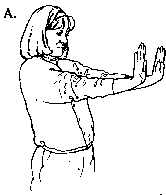
Straighten both wrists and relax fingers.
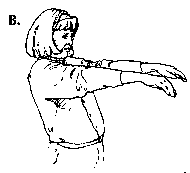
Make a tight fist with both hands.
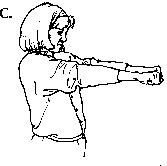
Then bend both wrists down while keeping the fist. Hold for a count of 5.
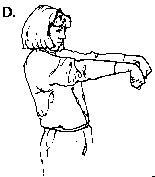
Straighten both wrists and relax fingers, for a count of 5.
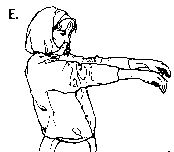
The exercise should be repeated 10 times.
Then let your arms hang loosely at the side and shake them for a few seconds.
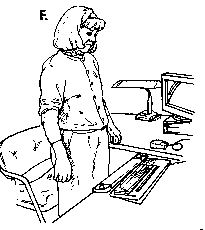
Of course, prevention is better than cure. Take 5 minute breaks from the computer every 15 minutes or so to prevent all this from happening and perhaps save your eyes as well - before it's too late.
+copy.jpg)




No comments:
Post a Comment